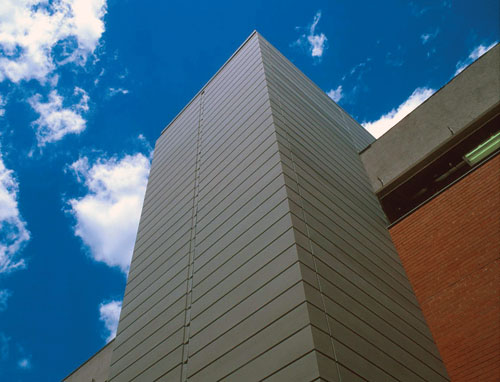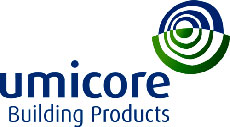Zinc Roofing and Wall Systems
Zinc Wall Panel Applications
Metal wall and façade panels are often selected to create a durable exterior skin that contributes to an overall high quality building envelope. Accordingly, wall panel manufacturers have developed innovative systems which use all the material qualities of zinc described above plus they have developed a range of systems supplied with preformed finishing accessories produced specifically for covering facades, for both new construction and renovation. Several types of wall panels include:
Flat Wall Panels
For walls, standing seam systems, either vertical or horizontal, are popular when using zinc. This traditional system allows long strips of profiled zinc panels to be assembled by forming single folds on the upstands. The sheets are laid on continuous sheathing and anchored using a combination of fixed and sliding clips. This system provides maximum water and wind resistance and is generally found to be an easy and cost effective installation. Further, it can be integrated with roofing systems for visual continuity, installed on curved surfaces, and applied to new or renovation projects. Smaller sized panels are also available primarily for flat facades that simplify installation but have more visible seams which may be desirable only in certain designs. Design professionals should refer to the manufacturer regarding product thickness for zinc projects because it will vary depending on the panel and sought-after aesthetic.
Rain Screen Panels
Rainscreen applications are increasingly popular with design professionals and zinc is an excellent choice for this type of system. As with masonry rainscreen, flashing and weep holes need to be provided at the base, as well as the head details, of the exterior wall. An advantage with zinc wall construction is that it doesn't require caulking in the joints. This system utilizes an air cavity between the wall and cladding to produce a type of chimney effect that provides air flow and may improve energy efficiency. The wall behind the rainscreen is treated as the water barrier layer of the wall assembly with the anticipation that some water is allowed to penetrate the rainscreen surface. The flow of air in the cavity between the rainscreen and the water barrier allows for evaporation while also providing a means of drainage in this cavity down to the bottom. For rainscreen applications, both flatlock and interlocking systems are common. Flatlock panels are square or rectangular units that are attached to a substrate with their corners left open in order to allow condensation to drain or dry. These panels can be designed into facades using a running bond pattern, a stacked bond pattern, or even a diagonal diamond shaped pattern. The size and scale of the patterns will depend on which panels are selected, of course. Interlocking panels are mounted on hat channels placed either vertically (for horizontal panels) or horizontally (for vertical panels). These channels provide the required air flow as well as ability for water and condensation to weep out. They are intended to be fixed onto a framework of galvanized Z girts or hat channels as appropriate to the design using metal clips which are concealed in the inside edge of the groove. Many have the advantage of requiring no sealants, gaskets or butyl tape in the panel joints meaning no dirty streaks will be created from them and maintenance is notably reduced or eliminated. Regardless of the type of panel used, rainscreens are suited for both new and renovation projects since the fabricated metal panels give them great structural rigidity over long vertical and horizontal distances. Further, some panels can be designed and specified to be fully pressure equalized assuring the best ongoing performance over the life of the building. Finally, since the zinc metal panels are not laminated nor a composite, they will never delaminate.
 |
Photo courtesy of VM Zinc, USA Zinc wall panels installed as a rain screen with deep reveal joints in a stacked bond. |
Decorative Shingles
Textural walls are another application of zinc that is gaining attention for both interior and exterior walls. Corrugated material is perhaps one of the oldest wall cladding applications, one that has a familiar look in rural and marine settings. Exterior corrugated zinc cladding requires a few extra considerations. When panels are laid in a shingled style or separated by a reveal, that reveal must include a drainage system behind it. Reveals can be detailed in a similar fashion to a rainscreen system and mounted on galvanized steel hat channels. In some peaked roof applications, the gable end wall is enhanced by the use of decorative zinc shingles. These pre-formed, pieces are typically designed for overlapping, easy installation that produce very good weatherproofing on vertical wall surfaces and can be integrated with a full range of flashings for an all metal envelope where desired.
Using Zinc With Other Building Materials
Zinc metal products will provide the outer weathering barrier of the roofing or wall system, but obviously coordination with other building components is critically important. Trained and experienced installers are a must as with any installation, but architects and designers should take care to understand the appropriate substrate, insulation, and framing support systems that are suitable for a given design. Product manufacturers have typically developed specific information on these points and even have entire product systems that are designed to work with particular insulation materials, provide more structural support of their own, or be assembled in smaller panels to allow for greater flexibility. This is significant because certain products when placed in contact with zinc can have detrimental effects on the appearance and/or structural integrity of the zinc. In particular, zinc used in combination with copper and mild steel needs to be addressed, although there are no reactions with other metals. When zinc contacts copper in the presence of an electrolyte (such as water) a galvanic reaction would lead to corrosion of the zinc and subsequent failure of the roof or wall. Run off from a copper surface to a zinc surface must be avoided under all circumstances due to the fact that zinc will become stained by the runoff. Zinc in contact with mild steel is not desirable either, due to similar electron transfers between the metal resulting in zinc corrosion and deterioration. In general, water should not be allowed to run from a higher potential metal to a metal with a lower one. Install metals in the following order: (from top to bottom): Aluminum, Zinc, Galvanized steel, Lead, Copper.
When looking at non-metallic products, zinc has been proven suitable adjacent to limestone since a number of limestone buildings in Paris have numerous zinc protective flashings located between floors. The run off from limestone onto zinc material is acceptable. However, limestone dust and gypsum dust that are generated during cutting operations can react with zinc in the presence of water and form a superficial coating. The zinc surface must be cleaned of any limestone and gypsum dust. No dust should be in contact with unprotected zinc and good construction practices should be used to limit the amount of dust.
Examples of acceptable contact products for zinc include lead, aluminum (painted, anodized, or bare), galvanized steel, stainless steel and compatible woods including pine, spruce, scotch pine, and poplar. Examples of unacceptable contact products and run off for zinc include but is not limited to copper, steel (non galvanized), gypsum dust/ limestone dust, mortar, rosin paper, bituminous membranes, products with fire retardant and preservation treatments, acidic cleaners, and non-compatible woods including larch, oak, chestnut, red cedar, Douglas fir, white cedar, and all woods with a pH less than 5.
Conclusion
Installed correctly, a building that is clad with zinc wall or roofing panels will have the potential to be a long lasting, durable, attractive, and truly sustainable building over the course of its very long full service life. Across the United States, design professionals increasingly turn to zinc for its inherent beauty, malleability and long-lasting appeal for commercial, public and residential projects. These buildings will stand the test of time, lasting for many, many years while reflecting their natural zinc patina for people to admire. Meanwhile, their owners will also enjoy these investments for their low-cost maintenance needs. Architectural zinc roofs and walls contribute to the industry's sustainable building ideals and the possibilities of unique design forms. As the misconceptions about zinc are cleared away, more professionals are choosing it for meeting customer demand for long-lasting, low maintenance products that can have a low impact on the environment.
Peter J. Arsenault, FAIA, NCARB, LEED-AP practices, consults, and writes about sustainable design and practice solutions nationwide. www.linkedin.com/in/pjaarch
 |
Umicore Building Products is the world's leading producer of zinc construction products. Their roof panels and wall systems have been used on a wide array of prestigious buildings across the country. www.vmzinc-us.com |








